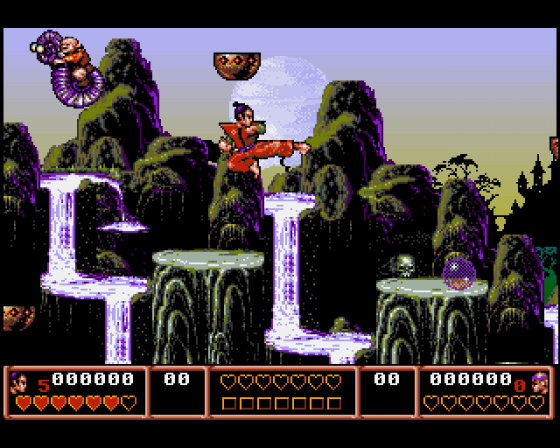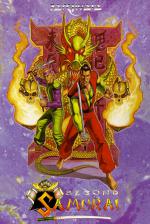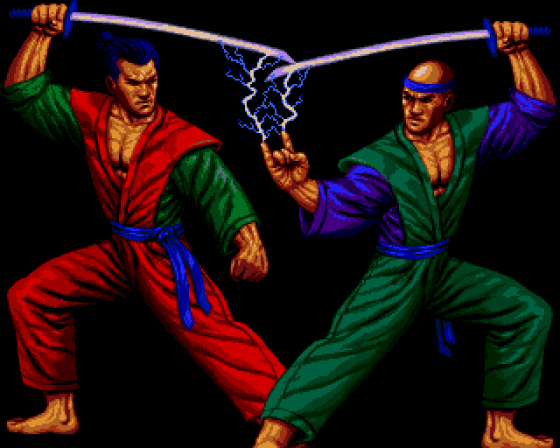
Amiga Power
 1st December 1993
1st December 1993
Categories: Review: Software
Author: Jonathan Nash
Publisher: Psygnosis
Machine: Amiga 500
Published in Amiga Power #32
Samurai or ninja? It's hard to tell with these 'modern' haircuts.
Second Samurai
One thing that has plagued the computer industry since its inception is petty machine rivalry. The early days saw the world gripped by pointless and depressing arguments along the lines of "My X is better than your Y", where X and Y were variables dictated by current computer trends. It's a little-known fact that the major computer manufacturers got together in 1986 in order to bring an end to the so-called Tedious Put-Down Wars. Sadly the talks fell apart when Clive Sinclair proposed that while, yes, every computer had its classic games and hence none could be regarded as actually being worse than any other, you really had to admit that those on the Speccy were, in a non-tedious put-downish way, far superior to those on all other formats. The representative from Commodore argued "Yeah, baldy? Come over here and say that," and things got unsalvageably out of hard when Alan Sugar started putting the boot in. [Allegedly - Ed]
Things have been pretty much the same ever since, and the whole thing's been given a ghastly new lease of life with the relatively recent popularity of consoles. Hopefully Amiga Power readers are far too mature to engage in such feeble drivel and will not, for example, guffaw disdainfully at anybody who happens to own a SNES when I reveal that the long-awaited SNES conversion of the excellent Amiga platformer First Samurai was absolute crap.
Second Samurai, the polite-ripple-of-applausingly-named sequel, treads much the same path as the original. Yon Demon King is again legging it through the time lanes with you in hot pursuit and again the soundtrack is replete with groovy orchestral samples and feudal Japanesey groans and yells, including everyone's favourite, "Oh no! My sword!". The big difference this time round is that Vivid Image have cleverly exploited the dual meaning of the title and introduced a second samurai: it's our old friend Simultaneous Two-Player Game once more. So, naturally, Second Samurai is at least twice as good as the original. Or is it? Hmmmm? Well, actually, no it isn't. The best two-player games are based on conflict, with the two of you locked in mortal combat over the racing track or the fighting ring or whatever. Even with the archetypal co-operative two-player game - Gauntlet 2 - there was an element of landing your friend in it by nipping round a corner and leaving him to face the opposition alone, or letting the 'it' monster get him then screaming with laughter as the monsters were drawn towards him. (Naturally, he'd be doing his best to pass on the 'it' curse to you while all this was happening.)

Due to the nature of Second Samurai - big graphics, platform gameplay - the only real sense of interpersonal conflict comes when you both rush for the bonus weapons.
You can't split up, you can't trick the other player into wandering into an ambush (because the monsters will go for you as well) and even the sword-conserving magic force from the first game is a shared commodity. There is an option whereby your blows hurt the other player, but this is far more frustrating than fun as you end up getting in a terrible mess trying to stay out of each other's way. I dunno. Obviously the two-player mode adds that 'human element' to the game, and there's no denying it's a bit of a laugh, but, well, it's old-fashioned. Instead of adding massively to the gameplay, it just feels tacked onto the one-player game. Most damningly, when I was playing on my own, I didn't miss the second player at all.
So it's lucky the one-player game is so darn funky then, isn't it? Yes.

One of the criticisms you could aim at dear old First Samurai without fear of being trampled underfoot by its legions of fans was that the puzzles were terrible. You came to an apparently impassable bit, you rang a handy magic bell and some wizened old bloke appeared and solved the thing for you. At least in the sequel you get to work it out for yourself, which typically involves thinking about the mechanics of the puzzle for one-sixth of a second and then walking back three screens to pick up that funny object you saw lying around in a suspicious fashion.
A-ha, but then you have to carry it to the scene of the puzzle, treading carefully because you can't fight with your hands full. And every now and again there will be a very neat problem to take you by surprise. An example. At one point, the floor is littered with deadly revolving spikes. If you're quick and you're lucky, you can probably get through. But wait! What about that sentient stone block (don't ask) guarding that prize in the screen above? Jump up, kick away that up-to-now inexplicably collapsible floor, and before you can say butter the block has crushed the spikes into the ground. Hurrah.
The basic platform gameplay has been wisely left alone. Lashings of punching and kicking cruelly-spiked minions, then getting hold of your famous sword and having a go with that as well. And bosses? This game has bosses to spare, two or three sprinkled around each level in a Turrican sort of way, and all of them cheerfully grotesque. The levels themselves deserve a special mention, packed with secret bonus rooms, atmospherically decked out in glorious competent-artist-o-vision, sufficiently differing from their fellows to raise excited questions in the House, and each featuring a unique and terrible deathtrap, from leaping fireballs to razor-edged mechanical crushers. Ah, it fair does you good to get away from jumping on cute nasties' heads in order to knock them off pleasantly rural landscapes.

The difficulty curve is also pitched just right. You find yourself really wanting to see the next level, you'll get that vitally important bit further each time, and the size of the game (three worlds of four huge levels) guarantees a fair bit of playing time before the Demon King is finally defeated in an undoubtedly ludicrously protracted climax. (Such is the absurdly large talent of the programmers that the game comes on a single disk, with a second providing an entirely wonderful piece of introductory music. Disk accessing is kept to a minimum - only new worlds, not levels, need be loaded - and overall the game does as much as possible to keep you enfolded in its atmospheric embrace. What a delicious change.)
Oh, look, I'll put it to you straight. Second Samurai is a brilliantly, programmed, terrifically playable, spectacularly addictive, graphically excellent and sonically boffo game with a hugely average two-player mode. I can't wait for Third Samurai, where no doubt we'll discover the Demon King managed to escape into another dimension or had a twin brother called Bernard or something.
The Bottom Line
Uppers: Improvements all round on the original game, which means a platform game of gigantic loveliness. It's big, it's playable, each of the twelve levels brings new features, the difficulty curve is spot on, there are loads of bosses, loads of secret rooms, no annoying disk hassles and you've got a sword.
Downers: The simultaneous two-player mode is disappointingly lacklustre, and you could argue that the whole thing's "just another platform game". (But let me tell you, you won't find another platformer more polished than this.)
Raf Cecco and co do it again. Those improvements I mentioned over the original aren't all that major, but they're more like refinements to an already impressively-tiered cake. Er, it just goes to show that there's life in the platform game yet, damn its eyes.










